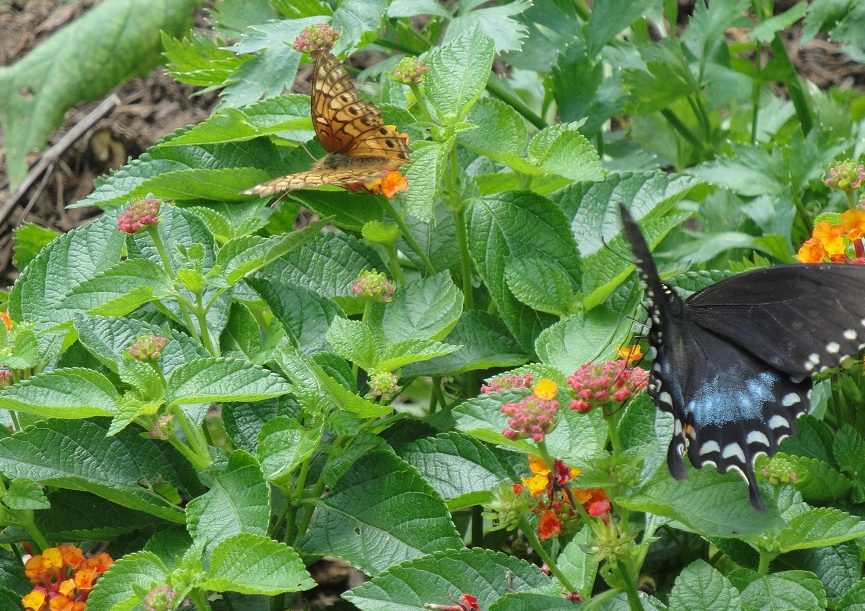Page 2
Long Vines That Might Smother the Grass
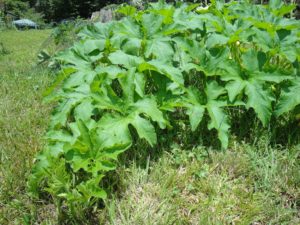
Pumpkin ‘Renegade’.
This year I planted some pumpkins, hoping the long heavy vines will kill the grass. Well, the three I planted south of the sunflower patch are well on their way. Each one has 1 or 2 little pumpkins that tripled in size in a week.
Every few days or after rain, I spray the stems with Bt. As young squash vine borers (larvae of a moth) eat their way into the hollow stems of some cucurbits, they also ingest the Bt, which just about stops them in their tracks. Once the larva gets inside the protective stem, it feeds on the tissues, causing the plant to wilt and likely die. By mid-summer, though, these gray and orange moths no longer lay eggs.
It’s often worth planting another crop of cucumbers, summer squash, and zucchini at this time. If your growing season is long enough, you’ll enjoy a second harvest season… with no borers!
***Update***: Although I didn’t mow grass in the pumpkin patch, the vines didn’t kill it. After the pumpkins had been harvested, I mowed down the withering vines. 8/25/22
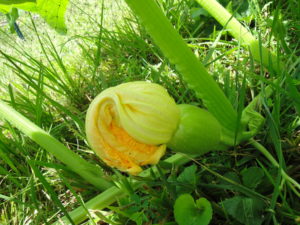
A young pumpkin.
Next To the Tree Stumps
A few rotting tree stumps stand a few feet tall and wide, and at the base is nicely composted organic matter. So, I planted leftover French Charentais ‘Savor’ melons, some zucchinis, Armenian cucumbers, and tomatoes. Their foliage looked terrible when planted, but the plants have recovered and look quite good, actually.
We’ve had frequent horrendous thunderstorms and horribly hot, humid weather this season. But provide those stressed plants with fertile ground, give nature a chance, and see what happens. I’ll probably get fruits from them, and they will have killed off more grass by autumn. (***Update***: I’ve harvested several tomatoes, cucumbers, basil, 2 ‘Savor’ melons, and the most delicious ‘Magda’ zucchini from the garden in the photo, below. 8/5/2022)
These areas are favored by the five-lined skinks, which hide in loose soil and behind decomposing shreds of bark barely clinging to the stump. One colony of termites was disrupted and sprayed with horticultural oil. I declined a gentleman’s kind offer to level the old tree stumps.
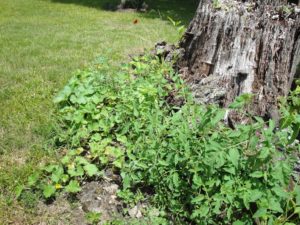
A mixture of leftover ‘Savor’ melon, tomato, and zucchini plants.
Patches For Pollinators: Don’t Mow Here
Here’s what I’ve been doing since the springtime, when all sorts of pretty weeds started popping up throughout the lawn.
For the biggest time savings when mowing grass, leave large areas of a weedy lawn alone while the “weeds” are in flower. “Patches for Pollinators” are areas of concentrated weed growth that can be quite attractive in their own right. Simply mow around them, creating sizable islands or bands of color and character that shift, in a few weeks’ time, to other areas of the lawn as those weeds come into bloom. I call it “Strategic Avoidance”.
These patches might be 500 square feet or 50 or only 5. The slope outside the basement door and the uneven ground behind the carport might get mowed every other time, or less often than that in dry weather.
Giving this practice a name (“Patches for Pollinators”) lends legitimacy to the purpose. Local pollinators benefit from eagerly sought-after sustenance. In addition, many moths, butterflies, and other insects complete their entire life cycle on that little patch of unmown ground.
Many of those insects become food for birds, toads, and the tiny red-bellied snake. Skinks live here, too; these harmless little lizards have bright blue tails that readily detach when caught by predators. Skinks feed on insects, and I’ve seen females protecting their 1/3″-long oval white eggs.
This approach might not be acceptable where HOA’s rule supreme or where the community norm calls for tightly clipped lawns. But I now live in the country. This is where a “lawn” that looks green from a distance and is cut fairly regularly is good enough. Think of all those resources—chemicals, fertilizer, seeds, water, time—not wasted on a nearly lifeless, monocultured lawn. And enjoy those well-fed birds, amphibians, and reptiles.
Weeds To Watch
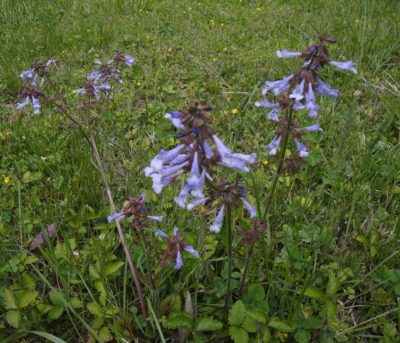
Recently, I chatted with a customer at the farmers’ market who said he’s doing the same thing in his yard. And a neighbor delayed cutting a long patch of purple salvia-like spikes (like those in photo, above) next to the road until after the blooms had faded.
Maybe this is common practice in rural communities. Who doesn’t love those bright golden buttercups seemingly suspended in the air a foot or two off the ground? They’re lovely!
Early Patches For Pollinators
- Wild violets.
- Great spangled (orange) and a female tiger swallowtail (dark form) mimicking the pipevine swallowtail.
Here, the first weeds I noticed were the violets (Viola spp.), blooming randomly in fall and winter, and heavily in spring. Most are found in partial shade close to the woods. They’re notoriously difficult to eradicate, so I don’t even try. I even brought one (V. sororia ‘Freckles’, with blue-spotted white flowers) from Maryland.
Violas host the meadow fritillary and the great spangled fritillary butterflies, while the gulf fritillary caterpillars feed on passionflower vines.
This violet, native to the eastern U.S., is also edible (salads, tea), and high in Vitamins A and C. But don’t consume it if you’ve treated the area with chemicals. A regimen of fewer chemicals—or no chemicals—applied to your property is more hospitable to the insects and animals, creating a healthier environment for everyone.
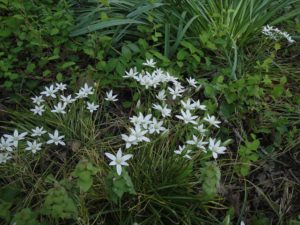
Star of Bethlehem.
Next to emerge was the Star of Bethlehem (Ornithogalum umbellatum), a short but rather invasive spreader. It’s native to the Old World but has naturalized here. This heavy bloomer grows from small bulbs in the ground, and the narrow leaves resemble those of crocus. Their starry white flowers close in the evening. Very pretty against the dark shadows of the woods behind them.
Also blooming in spring were those lilac-purple spikes on purple- or green-leaved plants that look like some sort of salvia. (***Update***: this plant appears to be the native lyre-leaved sage, Salvia lyrata. 7/7/2023)
Other unidentified weeds grew early in the season, and pollinators were buzzing with activity in the flowers. At that time of year, they’re grateful for any source of food. These insects pollinate flowers elsewhere during their daily rounds, including farmland, forests, orchards, meadows, and our home vegetable gardens. So, you can see how their activities contribute to agricultural productivity and impact regeneration of natural areas beyond our own property lines.
Late Spring and Summer Patches for Pollinators
Various unidentified white- or yellow-flowering weeds bloomed through spring and summer. Some look like dandelions, asters, and daisies. One had foliage resembling the lacy, delicate yarrow (photo, below), with golden umbels on stalks up to 2′ tall. The white-flowering common yarrow (Achillea millefolium) grows in patches around the sunny front yard, even where the soil had been disturbed when public water was piped into the house.
- Bright gold flowers on tall stalks.
- A bee collecting pollen.
- Pollinators and house finches love this one.
- Common yarrow.
As a legume, white-flowering clover (Trifolium, photo, below) has nodules in the roots. Bacteria (Rhizobium) living in the nodules gather nitrogen from the atmosphere and convert it into a form used by plants. Consequently, grass and weeds growing near it appear darker green.
Clover hosts the clouded sulfur, the alfalfa sulfur, and eastern tailed blue butterflies. Honey bees, of course, treasure the flowers and produce clover honey. Another legume called black medic (Medicago lupulina), an annual, has smaller, similar foliage and yellow flowers.
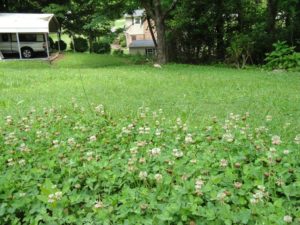
A patch of clover.
Cinquefoil (Potentilla simplex), with yellow flowers, and wild strawberry (Fragaria virginiana) creep along the ground on wiry stems. White-flowering wild strawberry has edible little red fruits eaten by birds and small animals.
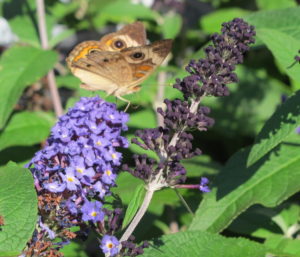
Common buckeye butterfly on butterfly bush.
Buckhorn plantain (Plantago lanceolata) and broad-leaved plantain (P. Rugelii) bloom in summer. These plants host buckeye and Baltimore butterflies. I’ve seen many buckeyes this year.
Lespedeza (L. striata) is a small woody plant with 3 leaflets and small pink flowers that attract bees. An identifying feature, with magnification, is parallel veining off the main vein. This plant hugs the ground, so most of it escapes the mower’s blade.
Patches For Pollinators: Living Proof
(This section added 8/5/2022.)
Commonly among moths and butterflies, larvae are quite particular about their host plants. Monarch butterflies, for example, lay eggs only on hardy butterfly weeds (Asclepias spp.). Fritillaries need violets. I saw my first great spangled fritillary racing through the yard yesterday. Adults, though, are general feeders, taking nectar from various species of plants, native or not.
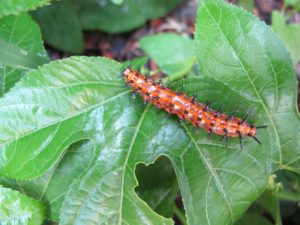
Gulf fritillary larva.
Gulf fritillaries (not a true fritillary, but a distantly related longwing) lay eggs on passionflowers (Passiflora). I’ve seen many males sipping nectar from cosmos and lantana flowers this month, but no females yet. They normally lay eggs quite late in the season, so I check the passionflower vine for “damage” every day while working outside.
It is critical to the survival of these insects to include many native plant species in the landscape. It’s as simple as that. Have you wondered where all the butterflies, ladybugs, and songbirds have gone? If you want to encourage populations of all forms of wildlife, concentrate on native species of trees and understory plants. Tolerate holes in the leaves, and let the weeds grow!
I’m delightfully surprised by the numbers of moths, bees, and butterflies occupying this property. Rural surroundings, a chemical-free environment, and “Patches for Pollinators” contribute to this biological diversity.
The Saddleback Caterpillar
(This section added 9/4/2022.)
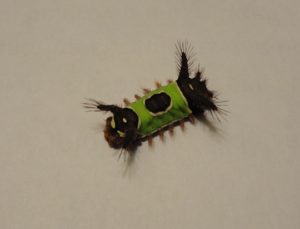
The saddleback caterpillar.
***Update***: Well, let me rephrase that. I’m delightfully surprised by most insects living around here. I was hoping to get through one summer without encountering that nasty little insect called the saddleback caterpillar (Acharia stimulea). Barely longer than 1″, it delivers a wallop of a sting! It feels like a hundred tiny hot needles piercing the skin, and the effect, with me, can last a few weeks if the area is touched. Those who suffer more severe reactions require medical attention.
The saddleback is one of the “slug” caterpillars, named for the way it glides over surfaces using mucus and suckers. At maturity, it’s a dark brown moth with small white spots. Larvae feed on a large number of hosts, including trees, shrubs, annuals, and perennials. They also feed on vegetables, as I was reminded recently when working in the garden. I had barely brushed the little devil in the photo, above, but immediately recognized that feeling.
These caterpillars don’t occur in large numbers in the landscape, thankfully, as most succumb to fungal infections and parasitic wasps. But when I do see them, they succumb to the tip of my trowel and a shallow grave.
Another tiny insect I’d never seen or felt before stung my thumb. Grabbing a sunflower by the stem, I felt a sharp throbbing pain for 10-15 minutes. It subsided at that point but didn’t entirely disappear for a week. I looked all over for the source of this discomfort but couldn’t find it. A few days later, when discarding old tomato plants at the edge of the woods, I felt it again on my leg. Didn’t see anything…then it bit again. This time, I saw a thin, tan-colored insect barely 1/2″ long, which I smashed. It is, as yet, unidentified.
Some are wondering, with all those “dangers” lurking in the garden, why spend so much time there? Without hesitation: it’s what I do. It’s what I love. Innumerable benefits… Gloves? What?!
The Pretty Moths and Butterflies
Here are two moths found on the front porch this past week:
- A female Promethea moth.
- Rosy maple moth.
The Promethea moth (Callosamia promethea), also called the spicebush silk moth, has a 4½” wingspan. It’s native to deciduous forests along the east coast to the Great Plains. The caterpillars feed on foliage of tulip trees, sassafras, spicebush, lilac, and black cherry. It pupates in its cocoon over the winter, wrapped in a dead leaf and suspended by a silk thread from a thin tree branch.
The rosy maple moth (Dryocampa rubicunda) is the smallest of the silk moths, with a wingspan less than 1¾”, and feeds in maple trees. This colorful little moth is native to the eastern half of the U.S. and southeastern Canada. An individual can live for 2 to 9 months, with older specimens spending most of that time in an underground cocoon over winter. Neither of these silk moths feeds as an adult.
- Confused eusarca moth (Eusarca confusaria), named for variable coloring. Larvae feed on aster, dandelion, goldenrod.
- One of the emerald moths (Synchlora). Feeds on flowers of composites, blackberry, legumes.
Now, if I had to spend more time cutting grass, I might have missed these beautiful creatures! What a pleasant surprise seeing the diversity of insects and animals living here.
With all the planted gardens, fenced areas holding potted plants for the farmers’ market, and the Patches for Pollinators, mowing time has been cut to 4 hours or less.
Yes, the weeds and I have come to an understanding. We’ve declared a truce. They can flower and feed all the local insects as long as they know they might get dug under and replaced with garden plants—many natives—that still benefit the environment. Maybe part of the sunny lawn will become a large patch of native flowering wildflowers. (I have the seeds, so…)
Concluding
In order to conserve populations of native insects and animals, we have to stop killing them off. The entire food chain depends on the survival of our smallest neighbors. These Patches for Pollinators might take some getting used to. But once I saw how the pollinators benefit—how the whole food chain can benefit—it’s a no-brainer. (***Update***: I now leave larger areas in meadow, and will mow it a few times each year. Spring 2023)
Leaving corridors of lush vegetation from one property to the next, one state to the next, is how we can save wildlife. And it can start in your own yard. This is something each of us can do, so won’t you try growing some Patches for Pollinators in your own back yard?
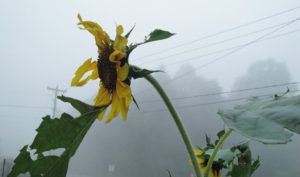
East-facing sunflowers eaten by caterpillars, but still flowering.
Headings
Page 1: Patches For Pollinators (Japanese Beetles, Japanese Beetle Life Cycle), Less Grass To Mow With Patches For Pollinators (New Gardens, From Crape Myrtle To Virginia Sweetspire, Not In the Pink, Vegetable Gardens, Miniature Broccoli ‘Happy Rich’, ‘Happy Rich’ and Insects, Tomatoes, Tobacco Hornworms, Tomato Update)
Page 2: Long Vines That Might Smother the Grass (Next To the Tree Stumps), Patches For Pollinators: Don’t Mow Here (Weeds To Watch, Early Patches For Pollinators, Late Spring and Summer Patches For Pollinators, Patches For Pollinators: Living Proof, The Saddleback Caterpillar), The Pretty Moths and Butterflies

